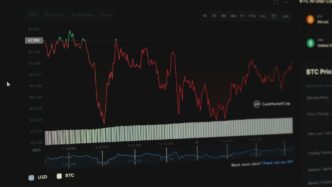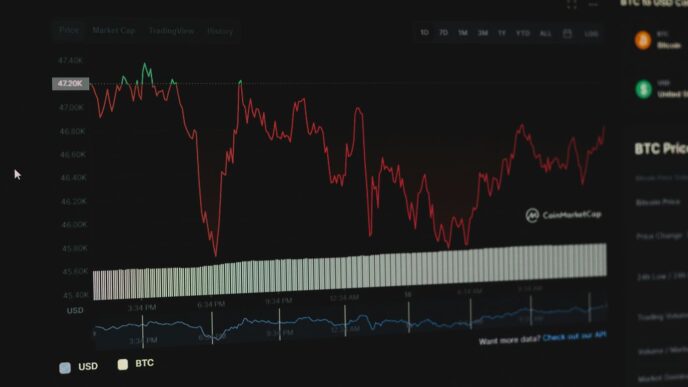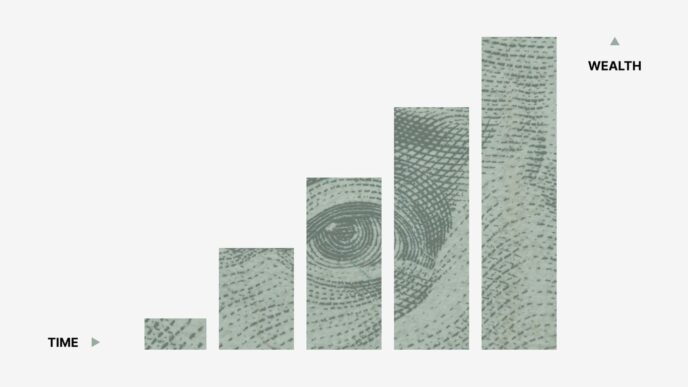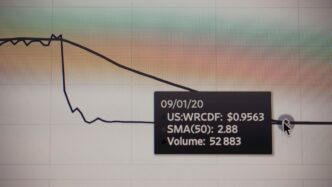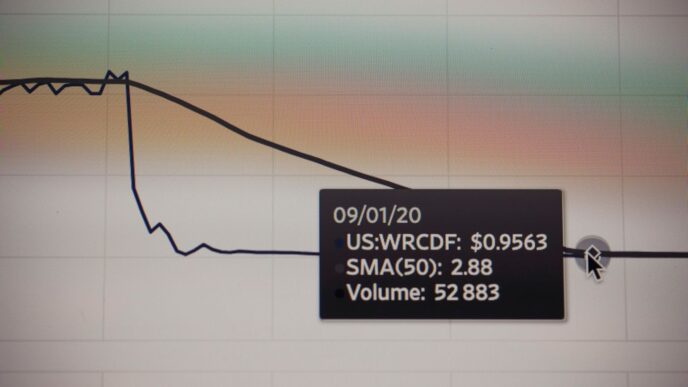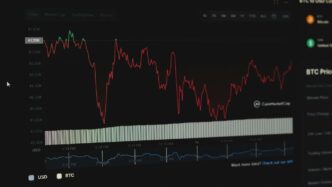Gold has been a popular asset for a long, long time, and it’s a big part of many investment plans these days. It has done pretty well over the years, going up about 8% each year for the last two decades. But, wow, its price can really jump around! It dropped a lot from 2011 to 2015, then bounced back by 2020. Lately, since late 2023, gold has been on a roll, hitting new high prices all the time. Right now, gold has actually done a little better than the S&P 500 this year. Looking ahead to 2025, we think gold will keep going up, maybe even hitting $3,150 an ounce by the end of the year. The price of gold is affected by a bunch of things, like big economic trends and how much gold is available versus how much people want it. Knowing how the gold market cap works is super important for anyone looking to put money into gold.
Key Takeaways
- The gold market cap shows the total value of all the gold out there, and it’s a good way to see how big the market is.
- Things like how much gold is mined, how much people want it for jewelry or investing, and what central banks are doing with their gold all change its value.
- Paper gold, like ETFs and futures, can really mess with the gold market cap, sometimes making it tricky to see the real price.
- It’s hard to keep track of all gold trading because a lot of it happens privately, which can make it easier for people to try and control prices.
- To protect yourself in the gold market, you should watch out for strange price changes, spread out your investments, and only buy from trusted sellers.
Understanding the Gold Market Cap
Defining Gold Market Capitalization
Okay, so what is gold market capitalization? Simply put, it’s the total value of all the gold out there. Think of it like this: if gold were a company, its market cap would be the total value of all its outstanding shares. As of today, July 5th, 2025, the estimated gold market cap is around $23.5 trillion. This number is calculated by multiplying the total amount of above-ground gold by the current price per ounce. It’s a useful metric for investors because it gives you a sense of the overall size and significance of the gold market compared to other asset classes, like stocks or real estate. It’s not a perfect measure, but it’s a good starting point. Understanding gold as an investment is key.
Key Factors Influencing Gold’s Value
Lots of things can move the price of gold, and therefore, its market cap. Here are a few big ones:
- Interest Rates: When interest rates are low, gold tends to look more attractive because it doesn’t pay any interest itself. Higher rates, on the other hand, can make gold less appealing.
- Inflation: Gold is often seen as a hedge against inflation. If people are worried about rising prices, they might buy gold, driving up its price.
- Geopolitical Uncertainty: Wars, political instability, and other global crises can send investors flocking to gold as a safe haven.
- Currency Fluctuations: The price of gold is often quoted in U.S. dollars, so changes in the dollar’s value can affect gold prices. A weaker dollar usually means higher gold prices.
- Supply and Demand: Basic economics! If demand for gold increases and supply stays the same, the price will likely go up. Supply can be affected by mining production, central bank sales, and recycling.
Historical Performance and Future Outlook
Gold has had its ups and downs over the years. In the early 2000s, it went on a big bull run, fueled by concerns about inflation and a weakening dollar. Then, after the 2008 financial crisis, it surged again as investors sought safety. More recently, gold prices have been volatile, reacting to changes in interest rates, inflation data, and geopolitical events. Looking ahead, predicting the future is always tricky, but several factors could influence gold’s performance. Continued inflation, geopolitical tensions, and a potential weakening of the U.S. dollar could all support higher gold prices. On the other hand, rising interest rates and a stronger dollar could put downward pressure on prices. It’s a complex picture, and investors need to monitor market news and do their homework before making any decisions. The history of the ratio of gold reserves to money supply is interesting. Comparing the US gold reserves to M1 expansion provides historical context.
Dynamics of Gold Supply and Demand
Global Gold Production Trends
Global gold production is a key factor in determining its market cap. It’s not like someone can just make more gold, right? The amount of gold mined each year influences the available supply, which in turn affects prices. If mining output decreases, and demand stays the same or increases, you’d expect prices to go up. Conversely, if there’s a surge in gold production, it could put downward pressure on prices. Major gold-producing countries like China, Australia, and Russia play a big role here. Keep an eye on their mining activities and any disruptions, as these can have a ripple effect on the entire market. It’s also worth noting that historical demand and supply can give you a good idea of where things are headed.
Investment Demand Versus Jewelry Demand
Gold demand comes from different places, and it’s not all the same. Investment demand, where people buy gold as a store of value or hedge against inflation, can be pretty volatile. When there’s economic uncertainty, investment demand tends to increase, driving up prices. On the other hand, jewelry demand, which is a big part of the overall picture, is more stable but also influenced by cultural factors and consumer preferences. For example, demand for gold jewelry in India and China is consistently high. Understanding the balance between these two types of demand is key to understanding price movements. Here’s a quick look at how they differ:
- Investment Demand: Driven by economic factors, inflation fears, and geopolitical risks.
- Jewelry Demand: Influenced by cultural traditions, fashion trends, and disposable income.
- Central Bank Demand: Government entities buying gold to diversify reserves.
Central Bank Gold Reserves
Central banks are big players in the gold market. They hold gold as part of their foreign reserves, and their buying or selling activity can have a significant impact on prices. Some countries see gold as a safe haven asset, especially during times of economic instability. If a central bank decides to increase its gold reserves, it can drive up demand and push prices higher. Conversely, if a central bank sells off a large portion of its gold holdings, it can flood the market and cause prices to fall. Central bank actions are often driven by their monetary policy goals and their outlook on the global economy. Monitoring these actions can provide insights into the gold price dynamics and potential future trends.
The Role of Paper Gold and Derivatives
Impact of Gold ETFs on Market Cap
Gold ETFs, or exchange-traded funds, have really changed how people invest in gold. Instead of buying physical gold, you can buy shares of an ETF that holds gold. This makes it easier for more people to get into the gold market, which can push the market cap higher.
Think of it this way:
- ETFs lower the barrier to entry. You don’t need a vault; you just need a brokerage account.
- They increase liquidity. It’s easier to buy and sell ETF shares than physical gold.
- They reflect market sentiment. ETF flows can show whether investors are bullish or bearish on gold. For example, if BTC’s market cap is low compared to gold, investors might see gold ETFs as a safer bet.
Understanding Gold Futures and Options
Gold futures and options are derivatives, meaning their value comes from the price of gold. Futures are contracts to buy or sell gold at a set price on a future date. Options give you the right, but not the obligation, to buy or sell gold at a certain price before a certain date. These instruments are used for hedging and speculation.
Here’s a quick rundown:
- Hedging: Miners might use futures to lock in a price for their gold, protecting them from price drops.
- Speculation: Traders might use options to bet on whether the price of gold will go up or down.
- Leverage: Derivatives let you control a large amount of gold with a relatively small amount of capital. This can amplify gains, but also losses. The paper gold market can significantly influence spot prices.
Potential for Price Manipulation in Paper Markets
The paper gold market, with its high leverage and complex instruments, has the potential for price manipulation. Because the volume of paper gold trades far exceeds the amount of physical gold, it’s possible for large players to influence prices in ways that don’t reflect actual supply and demand. This can involve spreading false information or using derivatives to push prices up or down.
Things to consider:
- Lack of Transparency: The complexity of derivatives can make it hard to see who’s doing what in the market.
- Large Positions: Big players can take large positions that move the market.
- Regulatory Challenges: It’s hard to detect and prove manipulation, even when it’s happening. Proven cases of gold price manipulation have occurred, highlighting the need for vigilance.
Regulatory Oversight and Market Transparency

Challenges in Over-the-Counter Trading
A big chunk of gold trading happens over-the-counter (OTC). What does that mean? Basically, it’s trading that doesn’t go through a formal exchange. This lack of a central exchange makes it tough to keep tabs on everything. Think of it like this: if all the trades are happening in back rooms, it’s hard to know what’s really going on. There’s less transparency, which can create openings for shady stuff. It’s like trying to referee a game when you can only see half the field.
Efforts to Enhance Market Transparency
There are groups trying to make the gold market more open. For example, the London Bullion Market Association (LBMA) sets standards for the London gold market. They’ve even got the LBMA Gold Price to try and make things clearer. The World Gold Council also pitches in by sharing market data and pushing for responsible investing. These efforts are important, but it’s a slow process. It’s like trying to build a house one brick at a time. We need more standardized reporting and better tracking of trades to really boost transparency.
Regulatory Bodies and Their Influence
Several regulatory bodies keep an eye on the gold market, but their reach isn’t total. In the U.S., the Commodity Futures Trading Commission (CFTC) watches over futures trading, including gold futures. They try to catch things like spoofing (placing orders you don’t intend to execute) and wash trading (buying and selling the same security to create artificial volume). The Securities and Exchange Commission (SEC) also regulates securities that might involve gold. Internationally, groups like the LBMA play a role. However, the OTC market still has less oversight, which leaves gaps. It’s a bit like having a neighborhood watch, but only half the houses are being watched. The effectiveness of these bodies is often debated, and keeping up with CFTC reports is a good way to stay informed.
Detecting and Protecting Against Market Manipulation

Identifying Unusual Price Movements
Okay, so you’re trying to figure out if someone’s messing with the gold market? First thing’s first: watch for weird price jumps. I mean, seriously out-of-nowhere spikes or drops that don’t seem to match any news or events. These sudden, unjustified shifts are often the first sign that something fishy is going on. Think of it like this: if the price of gold suddenly plummets right after a major bank makes a big move, that’s worth looking into. Keep an eye on volume too. Big price changes with low volume? Sketchy. Also, pay attention to moving averages and oscillators; unusual deviations can be a red flag. Spotting gold price manipulation isn’t easy, but being alert to these indicators is a good start.
Diversifying Gold Investments
Don’t put all your eggs in one basket, especially when it comes to gold. Diversification is key. Instead of just buying gold bars, consider spreading your investments across different asset classes. Think stocks, bonds, even other commodities. This way, if the gold market takes a hit due to manipulation, you’re not completely wiped out. Also, consider different types of gold investments. Maybe some physical gold, some gold ETFs, and some mining stocks. The more spread out you are, the better your chances of weathering any storms. It’s like having a backup plan for your backup plan. Diversifying your gold investments is a smart move to reduce risk.
Importance of Reputable Dealers
Where you buy your gold matters. A lot. Stick with dealers who have a solid reputation and a long track record. Do your homework. Check online reviews, ask for recommendations, and make sure they’re transparent about their pricing and fees. Avoid anyone who seems shady or pushes you to make quick decisions. Buying from reputable dealers is like buying a car from a trusted mechanic versus some random guy on Craigslist. You want someone who knows what they’re doing and isn’t going to rip you off. Also, consider getting your gold graded by services like PCGS to ensure authenticity. It’s an extra step, but it can save you a lot of headaches in the long run.
Macroeconomic Factors Shaping Gold’s Future
Influence of the U.S. Dollar and Real Yields
Okay, so how do big economic things affect gold? Well, the U.S. dollar is a big one. Usually, if the dollar gets stronger, gold gets cheaper for people using other currencies, and demand goes down. If the dollar weakens, gold gets more attractive. It’s like a seesaw. Real yields – that’s what you earn on investments after inflation – also matter. When real yields are low or negative, gold looks better because it doesn’t pay interest, but it holds its value.
Inflationary Pressures and Gold’s Role
Everyone talks about inflation, right? Gold is often seen as a hedge against it. The idea is that as prices go up, so does the price of gold, protecting your buying power. It’s not always perfect, but that’s the theory. If people are worried about inflation, they might buy gold to protect their assets. It’s like an insurance policy, but for your money. The table below shows the relationship between inflation and gold prices in the last few years:
| Year | Inflation Rate | Gold Price (USD/oz) |
|---|---|---|
| 2022 | 8.3% | 1,800 |
| 2023 | 3.7% | 1,950 |
| 2024 | 3.2% | 2,300 |
| 2025 (Projected) | 2.5% | 2,500 |
Geopolitical Events and Investor Sentiment
Big events around the world can really shake things up. Wars, political instability, trade disputes – all of these can make investors nervous. When people are scared, they often run to safe assets, and gold is a classic choice. So, if there’s a lot of uncertainty, demand for gold might increase, pushing the price up. Investor sentiment is a huge factor. Here are some examples:
- Increased geopolitical tensions often lead to higher gold prices.
- Positive economic news might decrease gold’s appeal as a safe haven.
- Changes in government policies can significantly impact investor confidence and, consequently, gold demand.
Investment Strategies for the Gold Market
Physical Gold Versus Digital Gold
Okay, so you’re thinking about getting into gold. Cool! One of the first things you gotta figure out is whether you want the real deal – physical gold – or the digital version. Physical gold means coins, bars, jewelry, the stuff you can actually hold. Digital gold is more like gold ETFs or gold futures, which are basically contracts based on the price of gold.
- Physical Gold: You actually own something tangible. It’s good for peace of mind, but storing it can be a pain. You need a safe, or a bank vault, and insurance. Plus, when you sell, you gotta find a buyer and deal with potential markups from dealers.
- Digital Gold: Easier to buy and sell. You don’t have to worry about storage. But you don’t really own gold; you own a contract. This means you’re exposed to counterparty risk – the risk that the other party in the contract can’t fulfill their obligations. Also, digital gold can be more volatile because it’s often traded by people trying to make a quick buck.
Long-Term Holding Strategies
Gold is often seen as a safe haven, something to hold onto when everything else is going crazy. The idea is that gold will maintain its value, or even increase, during times of economic uncertainty, inflation, or geopolitical turmoil. But just buying gold and forgetting about it isn’t always the best strategy. Here are some things to consider:
- Dollar-Cost Averaging: Instead of buying a big chunk of gold all at once, invest a fixed amount regularly. This way, you buy more when prices are low and less when prices are high, averaging out your cost over time.
- Rebalancing Your Portfolio: Decide what percentage of your portfolio you want in gold (say, 5-10%). Then, periodically (like once a year), check to see if your allocation is still on target. If gold has gone up and now makes up a larger percentage, sell some to bring it back to your target. If it’s gone down, buy more. This helps you stay disciplined and avoid getting too greedy or fearful.
- Consider the Opportunity Cost: Remember that gold doesn’t generate income like stocks or bonds. So, holding too much gold can mean missing out on potential gains from other investments. Think about your overall financial goals and risk tolerance when deciding how much gold to hold.
Utilizing Technical Analysis for Gold Trading
Technical analysis is all about looking at charts and patterns to predict future price movements. Some people swear by it, others think it’s nonsense. But if you’re planning to actively trade gold, it’s worth knowing the basics. Here’s the deal:
- Support and Resistance Levels: These are price levels where the price of gold has historically tended to bounce (support) or stop rising (resistance). Traders use these levels to identify potential entry and exit points.
- Moving Averages: These smooth out price data over a certain period (like 50 days or 200 days) to help identify trends. A rising moving average suggests an uptrend, while a falling one suggests a downtrend.
- Relative Strength Index (RSI): This is an indicator that measures the magnitude of recent price changes to evaluate overbought or oversold conditions in the price of gold. An RSI above 70 usually means gold is overbought and could be due for a correction, while an RSI below 30 suggests it’s oversold and could be ready for a bounce.
Technical analysis isn’t foolproof. It’s just one tool in the toolbox. It’s important to combine it with other forms of analysis, like fundamental analysis (looking at economic factors) and sentiment analysis (gauging investor mood), to get a more complete picture of the gold market and its potential direction. And always remember to manage your risk!
Wrapping Things Up: What Gold’s Future Might Look Like
So, as we look ahead to 2025, it’s pretty clear that understanding the gold market isn’t just about checking the daily price. It’s way more involved than that. We’ve talked about how gold has been around forever, always a big deal for investors. Even though it can jump around a lot, it’s still seen as a pretty good bet over the long haul. Things like what the U.S. dollar is doing, interest rates, and just how people feel about the economy all play a part in where gold goes. And yeah, there are always whispers about manipulation, especially with those over-the-counter deals, but regulators are trying to keep things fair. For anyone thinking about putting money into gold, it really comes down to doing your homework, spreading out your investments, and maybe even holding some physical gold. Staying on top of market news is a good idea too. Gold’s story is still being written, and it’s definitely going to be interesting to see what happens next.
Frequently Asked Questions
What exactly is the ‘gold market cap’?
Gold’s market cap is the total value of all the gold that has been mined and is currently above ground. You figure it out by multiplying the total amount of gold by its current market price. It’s like checking the total worth of a company by multiplying its stock price by the number of shares.
What makes the price of gold change?
Many things can make gold’s price go up or down. These include how strong the U.S. dollar is, how much people want to invest in gold versus how much is available, and big world events like economic troubles or political unrest. When things are uncertain, more people tend to buy gold, which can push its price higher.
How do ‘paper gold’ and other financial products affect the gold market?
Paper gold, like gold ETFs (Exchange Traded Funds) and futures contracts, lets people invest in gold without actually owning the physical metal. These can affect the market by making it easier for more people to trade gold, which can influence its price. Sometimes, these paper markets can even make it seem like there’s more gold available than there really is.
Why is it hard to see all the details of gold trading?
It can be tough to see everything that’s happening in the gold market because a lot of trading happens privately, not on big public exchanges. This makes it harder to track all the deals. But there are groups and rules trying to make things more open and fair, like watching out for people trying to unfairly change prices.
How can I tell if the gold market is being manipulated, and how do I protect my investments?
You can spot unusual price moves by looking at charts and using special tools that show if the price is acting strangely. To protect your money, don’t put all your eggs in one basket; invest in different things. Also, always buy gold from trusted sellers to make sure you’re getting the real deal.
What big economic things will affect gold’s value in the future?
Big economic trends really shape gold’s future. For example, if the U.S. dollar gets weaker, gold often becomes more attractive. When prices for everyday goods go up (inflation), gold is often seen as a safe place to put money. Also, major world events, like wars or big political changes, can make people want to buy more gold as a safe haven.



